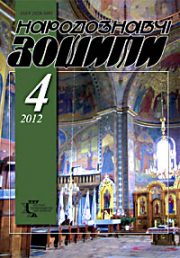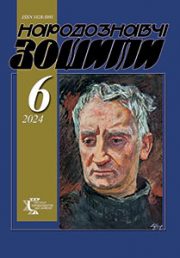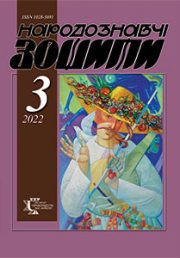The Ethnology Notebooks. 2025. № 4 (184), 939—947
UDK069.5:316.647.6:929О.Заливаха
DOI https://doi.org/10.15407/nz2025.04.939
BABII Nadiia
- ORCID ID: https://orcid.org/0000-0002-9572-791X
- Doctor of Art History, Professor,
- Vasyl Stefanyc Precarpathian National University,
- 57, Shevchenka St., 76000, Ivano-Frankivsk, Ukraine,
- Contacts: e-mail: nadiia.babii@pnu.edu.ua
Abstract. The relevance of the study is due to the painter’s jubilee date — the 100th anniversary of his birth, as well as the lack of an early biography of the artist Opanas Zalivakha.
The aim of the study is to analyse the means of artistic identity and self-identity of the artist of the sixties, Opanas Zalyvakha. The artist’s early works, first group and personal exhibitions are considered through a number of resonating factors: analysis of posters, catalogues, criticism, court records, and investigation protocols. Indirect sources that demonstrate biographical implications are of great importance. These include memoirs, pre-trial testimony, and secondary texts: mythology, changes in autographs and creative style.
Methodology. The study is based on the structural-functional method of the research, which allows us to consider the artist’s personal activity in the context of cause and effect. In the course of the study, the method of structural and typological analysis was applied. Iconological and graphic methods were used to determine the belonging of individual works to exhibition catalogues.
Results: The systematisation of the real source base covering the early creative activity of the dissident artist Opanas Zalyvakha allows us to assert that the national science operates with an extremely limited informative field regarding this period of the artist’s work. The additions made allow us to understand the scope of the first exhibitions, his manner, the chosen subjects, and partially the reasons for the persecution and closure of his personal exhibition in 1962. An unbiased analysis of disparate sources from private and public archives, sales auctions, etc. allowed us to identify the specifics of the cultural period and consider the early artistic and exhibition activities of Opanas Zalyvakha not only in a biographical sequence of facts, but as a variable model with the qualities of presentation of various practices, cause-and-effect relationships that sufficiently reflect the changes in the artist’s identification and self-identification and demonstrate resonance in the artistic community.
Keywords: Opanas Zalyvakha, exhibition activity, 1960—1962, nonconformism, potential sources, artist’s self-identity.
Received 20.06.2025
REFERENCES
- (1961). Exhibition of works by artists of the Tyumen region. Catalog: painting, graphics, sculpture and applied arts. Tyumen [in Russian].
- (1996). Opanas Zalyvakha. Painting, graphics, carving (catalog). Ivano-Frankivsk: Lileia-NV [in Ukrainian].
- Opanas Zalyvakha. Catalog. (2016). Ivano-Frankivsk: Lileia-NV [in Ukrainian].
- Hlibchuk, U. (2017). The connection between the earthly and the heavenly. Dzvonar. Collection of articles and memoirs about Afanas Zalivakha. Kharkiv: Human Rights [in Ukrainian].
- Zaretskyi, O. (2017). Opanas Zalyvakha is a friend of my parents. In: The Bell Ringer. A Collection of Articles and Memoirs about Opanas Zalyvakha. Kharkiv: Human rights [in Ukrainian].
- Marusyk, T. (2017). Through the eyes of the «youngest dissident». In: The Bell Ringer. A Collection of Articles and Memoirs about Opanas Zalyvakha. Kharkiv: Human rights [in Ukrainian].
- Panas Zalyvakha. Ascension. (1996). In: Alla Gorska: The Red Shadow of the Viburnum: Letters, Memories, Articles. Kyiv: Spalakh LTD [in Ukrainian].
- Zalyvakha, O. (1965). A wedding gift with the image of a «trident» was created by Opanas Zalyvakha for Mariia Kukhtiak. Ukrainian Liberation Movement (manuscript). Retrieved from: http://avr.org.ua/viewDoc/29565 [in Ukrainian].
- Sheko. Record of interrogation of the accused Afanas Zalyvakha dated October 4, 1965. Ukrainian Liberation Movement (manuscript). Retrieved from: http://avr.org.ua/viewDoc/29545?locale=en [in Ukrainian].
- Synytsia, & Baranov. Record of the search at artist Opanas Zalyvakha’s dated August 28, 1965. Ukrainian Liberation Movement (manuscript). Retrieved from: http://avr.org.ua/viewDoc/29535.
- Synytsia. Collection of explanations by artist Opanas Zalyvakha compiled by the officer of the UKGB in Ivano-Frankivsk Oblast Captain Synytsia for the period from October 28 to October 31, 1964. Ukrainian Liberation Movement (manuscript). Retrieved from: https://avr.org.ua/viewDoc/29536?locale=en.
- Sheko. Record of additional interrogation of the accused Afanas Zalyvakha dated November 22, 1965. Ukrainian Liberation Movement (manuscript). Retrieved from: http://avr.org.ua/viewDoc/29550.
- Sheko. Record of interrogation of the accused Afanas Zalyvakha dated September 15, 1965. Ukrainian Liberation Movement (manuscript). Retrieved from: http://avr.org.ua/viewDoc/29542?locale=en
- Sheko. Record of interrogation of the suspect sculptor Vasyl Turetsky in Opanas Zalyvakha case dated August 28, 1965. Ukrainian Liberation Movement (manuscript). Retrieved from: http://avr.org.ua/viewDoc/29568
- Ovsienko, V. (1999, September 20). Interview with Opanas Zalyvakha. Interview from Ukraine. Retrieved from: https://rozmova.wordpress.com/2019/01/25/opanas-zalyvakha-2/ [in Ukrainian].
- Koterlin, R. (2000). Interview with Panas Zalyvakha. November, 1999. KinetsKintsem, 2 [in Ukrainian].
- Palette of Being. Opanas Zalyvakha. Retrieved from: https://www.youtube.com/watch?v=klCiGWm6w00&ab_channel=ТарасМайстришин (interview) [in Ukrainian].
- (2025, 30.01). Private archive of N. Babii. Nadiіa Babii with August Basiuk (interview) [in Ukrainian].
- (2025, 30.01). Private archive of N. Babii. Nadiіa Babii with Orest Zaborsky (interview) [in Ukrainian].
- (2024, 20.02). Private archive of N. Babii. Nadiіa Babii with Stepan Ostasha (interview) [in Ukrainian].
- (2003). Private archive of I. Chmelyk. Catalog of the exhibition of works by the artist O. Zalyvakha 1962 from the private library of the Figol family (manuscript) [in Ukrainian].
- Gorb Tatiana Vladimirovna, Gorb Vladimir Alexandrovich(1903—1988). Russian artists biography database. Retrieved from: https://web.archive.org/web/20120309195613/http://www.leningradartist.com/bio/g.htm [in Russian].







